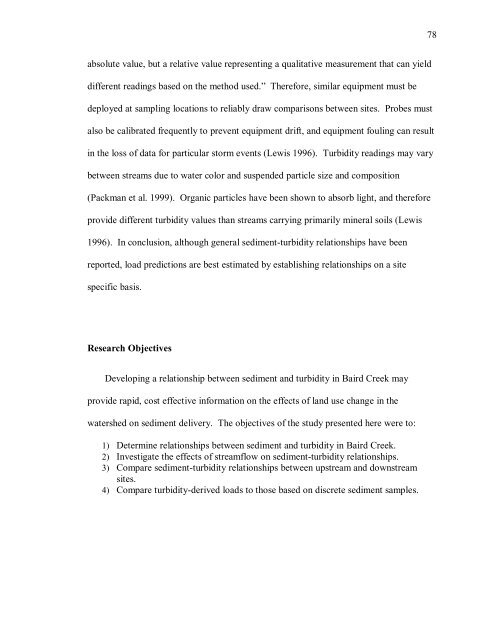CHAPTER 4 – ESTABLISHING A RELATIONSHIP BETWEEN ...
CHAPTER 4 – ESTABLISHING A RELATIONSHIP BETWEEN ...
CHAPTER 4 – ESTABLISHING A RELATIONSHIP BETWEEN ...
You also want an ePaper? Increase the reach of your titles
YUMPU automatically turns print PDFs into web optimized ePapers that Google loves.
78absolute value, but a relative value representing a qualitative measurement that can yielddifferent readings based on the method used.” Therefore, similar equipment must bedeployed at sampling locations to reliably draw comparisons between sites. Probes mustalso be calibrated frequently to prevent equipment drift, and equipment fouling can resultin the loss of data for particular storm events (Lewis 1996). Turbidity readings may varybetween streams due to water color and suspended particle size and composition(Packman et al. 1999). Organic particles have been shown to absorb light, and thereforeprovide different turbidity values than streams carrying primarily mineral soils (Lewis1996). In conclusion, although general sediment-turbidity relationships have beenreported, load predictions are best estimated by establishing relationships on a sitespecific basis.Research ObjectivesDeveloping a relationship between sediment and turbidity in Baird Creek mayprovide rapid, cost effective information on the effects of land use change in thewatershed on sediment delivery. The objectives of the study presented here were to:1) Determine relationships between sediment and turbidity in Baird Creek.2) Investigate the effects of streamflow on sediment-turbidity relationships.3) Compare sediment-turbidity relationships between upstream and downstreamsites.4) Compare turbidity-derived loads to those based on discrete sediment samples.
















